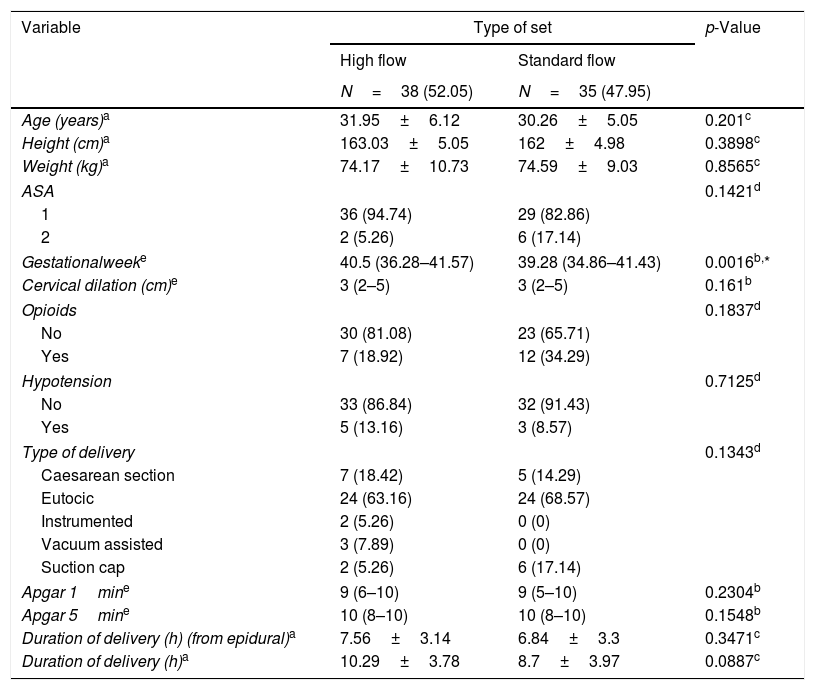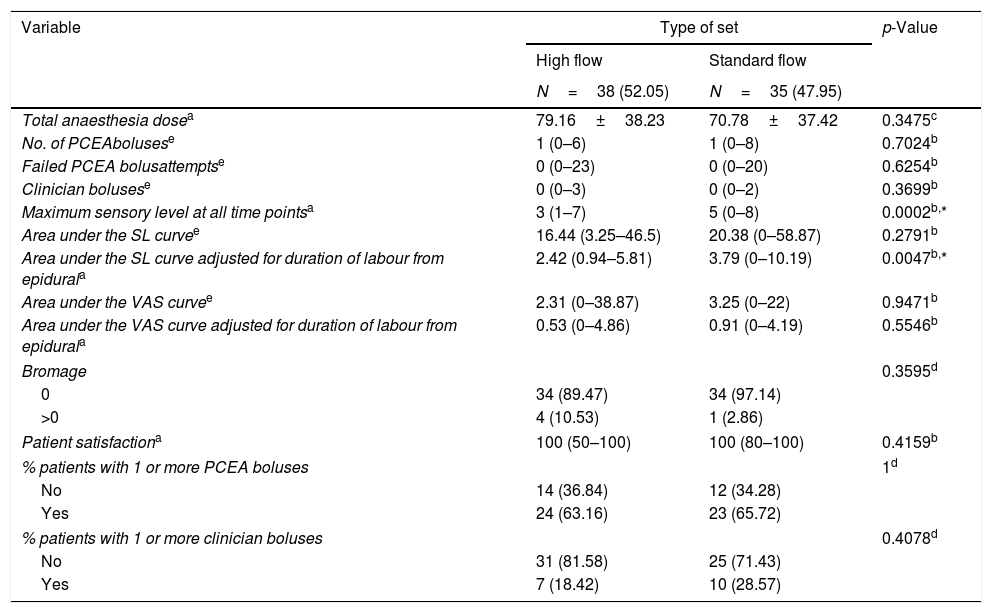The higher injection pressure obtained with epidural boluses give greater anaesthetic spread, and therefore better sensory block.
Therefore, it stands to reason that anaesthetic administered at greater injection pressure and a higher flow rate would spread to a higher sensory level.
ObjectiveOur aim was to compare the sensory level reached with the high flow and standard flow set at maximum rates.
Material and methodsWe included 73 primiparous women who requested epidural analgesia for labor using programmed intermittent epidural boluses of 0.1% ropivacaine at a flow rate of 10ml/h and 2μg/ml fentanyl plus patient-controlled epidural analgesia. The boluses were administered with a standard (250ml/h) or high-flow (500ml/h) infusion set, according to the usual clinical practice of each anaesthesiologist. The primary objective was to evaluate the sensory level reached. Secondary objectives were pain on a visual analogue scale, motor block measured on the modified Bromage scale, and anaesthesia consumption in terms of rescue analgesia (patient-controlled epidural analgesia) and anaesthesiologist-administered boluses.
ResultsThe median maximum sensory level reached was T9 in the high flow group and T7 in the standard flow group; this difference was statistically significant (p=0.0002). There were no significant differences in visual analogue scale, Bromage or rescue analgesia between groups.
ConclusionOur results show that the high flow set does not offer benefits. The use of such sets need to be evaluated due to their higher cost.
Una de las ventajas de utilizar bolos epidurales es que se ejerce mayor presión de inyección y por tanto más difusión produciendo un mayor bloqueo sensitivo.
Por tanto si a mayor velocidad de administración del bolo más presión se ejerce cabe esperar que el nivel sensitivo alcanzado sea mayor.
ObjetivoNuestro objetivo fue comparar el nivel sensitivo alcanzado con el set de alto flujo y el de flujo estándar a velocidades máximas.
Material y métodosSe incluyeron setenta y tres gestantes primíparas que solicitaron analgesia epidural utilizando bolos epidurales intermitentes programados a 10ml cada 60 min de ropivacaína al 0,1% con fentanilo 2ug/ml más analgesia epidural controlada por la paciente. Dichos bolos se administraron con set de infusión estándar a 250ml/h o de alto flujo a 500ml/h según la práctica clínica habitual de cada anestesiólogo. El objetivo primario fue evaluar el nivel sensitivo alcanzado. Los objetivos secundarios fueron la escala visual analógica, la escala modificada de Bromage y el consumo anestésico en términos de analgesia de rescate (analgesia epidural controlada por la paciente y bolos administrados por el anestesiólogo).
ResultadosLa mediana del nivel sensitivo máximo fue T9 en el grupo de alto flujo y T7 en el de flujo estándar, siendo dicha diferencia significativa estadísticamente (P=0,0002). No hubo diferencias significativas en la escala visual analógica, Bromage o analgesia de rescate.
ConclusiónEl set de alto flujo no ofrece beneficios en cuanto a los resultados analizados por lo que hay que valorar su uso ya que conlleva un coste adicional.
Artículo
Comprando el artículo el PDF del mismo podrá ser descargado
Precio 19,34 €
Comprar ahora












